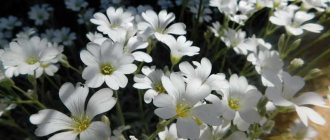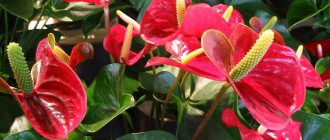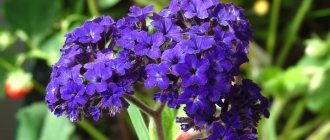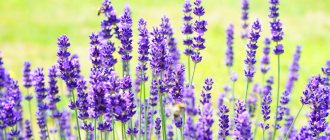Seaside cineraria (Cineraria maritima)
Not everyone knows that the popular ornamental crop with silvery and carved leaves and plants with beautiful flowers similar to daisies have the same name - cineraria. These outwardly dissimilar plants belong to the genus Cineraria or ragwort, family. Asteraceae.
Types and varieties for open ground
About 50 natural species of the genus Cineraria are known. Three are common in garden culture.
Cineraria maritima
A perennial plant native to the Mediterranean. In its natural environment it lives in rocky crevices.
In the climatic conditions of central Russia, it is more often used as an annual crop, but provided good shelter it can winter in open ground.
The plant is easy to remember by its appearance - feathery lacy leaves of an unusual white-silver color. The color of the leaves is fully visible during the day in sunlight. The flowers are yellow, inconspicuous in appearance. They are removed as they appear to improve the decorative appearance of the leaves. Used as a border plant, and when trimmed, as a carpet plant.
Common varieties:
" Cirrus ". Forms a bush 30–60 cm high. The leaves are oval, uncut, with serrated edges. Young leaves are silvery-green, becoming silvery-white in mature plants.
Silver dust
" Silver Dust ". Compact plant up to 25 cm in height with openwork silver leaves.
Cineraria bloody (hybrid)
Bloody Cineraria (Cineraria cruenta)
Her homeland is the Canary Islands. Just like the previous species, it grows on high mountain slopes.
Cineraria bloody is a biennial plant. In the middle zone, in open ground, it is grown as an annual. Depending on the variety, the plant reaches a height of 20–90 cm. The leaves are green, slightly pubescent, heart-shaped, up to 20 cm wide.
Valued for its spectacular daisy-like basket inflorescences. Their colors are very diverse: pink, purple, red, white, yellow. Many bicolor varieties have been developed. In such plants, the base of the flower around the eye or the border along the edge is white. The flowers are simple or double, small 2.5–4 cm in diameter or large 5–8 cm in diameter. The inflorescences are located in the center of the plant, rising above the leaves. Some varieties have a pleasant aroma.
Popular varieties and hybrids:
" Sympathy ". A low compact hybrid up to 20 cm, the color of the inflorescences is varied, monochromatic or two-color.
" Grandiflora ". A spectacular plant 45–70 cm high. Forms a spherical bush. Tall plants need support. The flowers are large, 6–8 cm in diameter, two-colored, white in the center.
" Venice ". Forms dense low bushes only 15–20 cm in height. The color of the flowers is rich, one-color or two-color: white-lilac, red-brown, white-violet, pink.
Cineraria graceful

Elegant Cineraria (Senecio elegans)
The culture also has southern origins. Its homeland is tropical Africa. Cineraria graceana is grown as an annual crop. Plant height is 30–60 cm. The stem is highly branched, with small pinnately dissected leaves; the leaves are large in the basal part. The flowers are white, red, pink with a yellow eye. They look simpler than those of bloody cineraria. But the plant is distinguished by its unpretentiousness and long flowering.
Cineraria of the “ Dwarf ” variety will take up little space in the garden; its bushes are miniature, no higher than 25 cm.
Features of planting and transplanting
We recommend reading our other articles
- How to store winter garlic
- Gloxinia flower
- Varieties of peonies with descriptions and photos
- Summer varieties of apple trees
Cineraria is planted and replanted several times over the entire period of its life. This is a very interesting plant, with its own vagaries, so below are the nuances of its planting and replanting that cannot be ignored.
- In open ground, cineraria is always planted in sunny areas, where there is natural partial shade at noon. If there is no such place, then the shadow is made artificially.
- The soil for the crop must be loose, because it is a taproot species - it will be difficult for the root to grow in hard soil. It must contain sand!
- The soil for planting is fertilized, peat and compost are added to it, if it is a garden crop, and if it is an indoor crop, you can buy fertile soil (enriched with minerals). Purchased land should ideally contain: leaf soil, compost, peat, sand, pieces of pine bark, ash - but this is only an approximate option.
Important!
Indoor cineraria is usually not replanted, since after flowering it is thrown away and a new sprout is planted. Although some hobbyists try to achieve color in the second and third year, this requires a lot of skill. And yet there is little chance that the plant will be as beautiful - even the leaves and stems usually fade.
- To plant seedlings, small holes with a depth of 20-25 cm are always made. It is desirable that the sprouts be in peat cups. But if the plant is replanted after dividing the bush or for another reason, the hole is dug a little deeper than the length of the existing root!
- After any planting or replanting, the soil must be compacted (lightly) and then watered. It doesn’t hurt to mulch garden crops with peat.
Selection of location and soil
In nature, cineraria grows in slight shade on mountain slopes on loose, nutritious soils of volcanic origin.
When growing in the garden and at the dacha, areas with the most suitable conditions are chosen for it. Well-lit, sunny places are suitable for seaside and graceful cineraria. Cineraria bloody also loves light, but it will be more comfortable in light partial shade without the hot and scorching sun.
The soil should be light and fertile, with an acidity level close to neutral or slightly alkaline. To increase nutritional value, compost and humus are added to the soil, for looseness - peat, sand, rotted sawdust, and if the soil is acidic - slaked lime.
First you need to take care of drainage. This is especially important for bloody cineraria, which does not tolerate stagnant water and may die.
General description of the species
Cineraria is considered a great find for many lovers who are involved in flower farming. Its diversity is so great that everyone can choose a plant to their liking. The description of the flower is very interesting. Its homeland is Madagascar and the tropics of Africa. This is the most amazing plant from the Asteraceae family, which has many common species that are not similar to each other.
There are currently approximately 1,300 species of Cineraria. Some of them are similar to the ragus family, and they are widely used in horticulture. Many people confuse this flower with daisies due to the similarity in the inflorescence.
Blooming cineraria looks like a dense cap with flowers of different colors and shapes. Flowers can be red, purple, blue, yellow, white and even purple. Deciduous species with unusual leaf shapes are suitable for growing in open ground.
Species diversity:
- The most original and decorative type is seaside or also called silver. The leaves of this species are very unusual, their color is like diamond dust or white-silver powder. Sea silver cineraria resembles a beautiful carpet that can be used to decorate flower beds, lawns, and borders.
- Indoor (bloody) has a rich colorful head of flowers. This plant can be easily grown in pots on a windowsill, and it also feels great in the garden. The elegance of the flower is given by its inflorescences, the petals of which can be pink, purple or blue.
- Elegant is characterized by simplicity and unpretentiousness. Long flowering makes this flower popular among many of its relatives.
- Cineraria hybrida is a perennial plant. The leaves of this flower are oval with small jagged edges, and the flowers can be of different shades, collected in a panicle.
Silver eucalyptus also belongs to the cineraria family, but only to the genus of giant trees. This plant is widely used medicinally to treat eye diseases. The Venice variety looks stunning due to its bright and dense flowering, covering large areas.
Growing from seeds
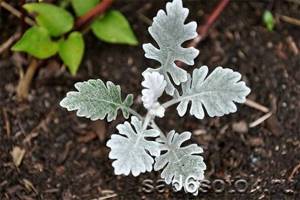
Growing Cineraria maritima from seeds
All types of cineraria are propagated by seeds. The crop can be grown by direct sowing into the ground only in the south, and in the conditions of central Russia it is grown only through seedlings. Seeds remain viable for a long time, up to three years.
Cineraria seaside is sown at the end of February or at the beginning of March.
Small containers are filled with nutritious and loose soil. It is advisable to sift it first to get rid of lumps. Then the surface of the earth is moistened with a spray bottle; the seeds should have enough moisture to swell and germinate. The seeds are laid out on the surface of the soil and lightly sprinkled with sand or soil.
The plantings are covered with glass or a plastic bag to create a moist and warm environment for them. The containers are placed in a bright and warm place with an air temperature between 20–25°C. Seedlings appear in 10–14 days.
After emergence, the optimal temperature for seedling growth is 18-20°C, with the exception of bloody cineraria. To set flower buds, it needs coolness and temperatures no higher than 15°C.
After another 3 weeks, the young plants will get stronger and will have 2-3 true leaves. At this time, they are dived into separate containers with a volume of 200–250 ml.
Bloody Cineraria will cause the most trouble when growing from seeds. It develops slowly and blooms 6–9 months after sowing. If plants are needed for summer flowering, then sowing begins in October. In short-day conditions, the seedlings are illuminated throughout the entire autumn and winter period; without this, flowering and strong bushes cannot be obtained. Due to waterlogging, seedlings may develop blackleg and various rots.
Home care
Cineraria, like any other plant, requires care, especially if it is going to be kept at home.
Here is a brief description of how to care for a flower:
- Correct watering technique. Since cineraria is a rather “capricious” plant, it needs to be watered with extreme caution. Settled water at room temperature is ideal for irrigation. Water should be poured only on the root of the plant; it is not recommended to get water on the leaves or flowers. It is very important to maintain soil moisture, but cineraria should not be over-watered. We need a “golden mean”.
- Good soil. As mentioned above, the soil should be nutritious and loose. Peat with compost in a 50/50 ratio is perfect for this type of flower. It would be a good idea to add a piece of bark to the soil, which will promote air permeability of the soil.
- Feeding. Cineraria needs to be fed, especially during the flowering period. Mineral fertilizer complexes will help keep the plant in order; with proper care, the flower will definitely thank its owner with beautiful blooms.
- Room humidity. Home care involves not only watering and fertilizing; you need to know that air humidity is very important for a flower. Cineraria must be kept at a temperature of 15 degrees. To make the flower more comfortable indoors, it is necessary to spray the air around the flower several times a day. Remember, this plant does not like drafts, so watch it carefully.

Cineraria in the courtyard of the house
Transplantation into open ground
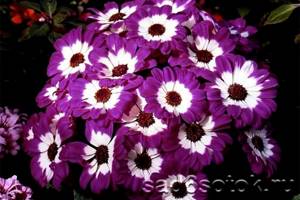
Cineraria bloody
In mid-May, cineraria is planted in the ground. In a permanent place, small holes are made with a distance of 20–25 cm between them and seedlings are planted in them along with a lump of earth. Plants are buried to the petioles of the lower leaves. The soil around the bushes is compacted and watered. Until the young plantings take root, they are shaded from the bright sun, watered moderately, and protected from night frosts by covering them with non-woven material. But for Cineraria Primorica, small return frosts are not dangerous. It can withstand temperatures as low as -2°C.
Planting and growing
Cineraria can be grown from seeds, cuttings, or using the method of dividing the bush. To achieve early flowering, it is necessary to sow seeds for seedlings in early March. To do this, carry out the following steps:
- Pre-prepared boxes are filled with substrate (sand and peat in a 1:1 ratio). There is no need to embed small seeds of the plant into the soil; simply distribute them over the surface of the soil and compact them slightly using a wooden ruler.
- Now you need to spray the plantings with a fine spray and cover with glass or film.
- Periodically, the homemade greenhouse is ventilated and the soil is moistened.
If everything is done correctly, the first shoots will appear after 1-1.5 weeks.
In the future, it is necessary to care for young seedlings:

provide them with bright diffused light;- when two true leaves appear, the seedlings are picked and planted in separate pots filled with peat;
- carry out timely watering, maintain the temperature in the region of 20−22 degrees and bright diffused lighting;
- with the onset of heat, the seedlings are taken outside for the purpose of hardening, which should last at least 7 days.
Flowers accustomed to wind and sun easily tolerate planting in open ground.
Landing in the ground
Planting in a permanent place takes place from mid-May. In this case, the following conditions must be observed:
- the area should be well lit, but in bright sun (at noon) the plants are shaded;
- Cineraria grows well in well-drained, fertile soil with a slightly alkaline or neutral reaction;
- holes are made in accordance with the dimensions of the rhizome, the distance between plants is 20-25 cm;
- seedlings must be rolled over together with a lump of earth;
- Before planting, the soil is watered and lightly compacted;
- If there is still a threat of night frosts, cover the plants at night.
Reproduction by vegetation
This method is used for propagating decorative deciduous varieties. The bush is divided. All work is carried out in the spring. To do this you need to do the following:
- Dig up the plant, and each division should include parts of the ground shoot and the root of the flower.
- After planting in a permanent place, the divisions must be well watered, which will facilitate and speed up the rooting of cineraria.
In summer, the flower is propagated by cuttings. To do this, you need to cut cuttings (10 cm) and remove their lower leaves. Planting should be done in light, nutritious soil, which must first be added with a weak solution of manganese. The cuttings also need to be prepared by placing them in a special solution that stimulates growth.
A day later, young plants are planted 1.5−2 cm deep in the ground and the soil around the plants is compacted. Initially, it is necessary to provide the seedlings with shelter. Regular plastic bottles with a cut off neck are ideal for this. Every day they are removed for 25-30 minutes so that the young plants can breathe.
After the first shoots have appeared, the seedlings are gradually accustomed to the open air, that is, to growing without shelter. For the winter they are placed in a cool place and only with the onset of spring are they planted in the ground.
Outdoor care
This flower cannot be called a whimsical plant, but growing and caring for cineraria still requires certain knowledge:
- Balanced watering. Lack of moisture can greatly weaken the flower, and its excess leads to rotting of the roots. However, the plant will tolerate drought more easily than “life in a swamp.”
- Regular removal of weeds and loosening of the soil. Wilted inflorescences must also be removed. This is done in order to allow new flower stalks to form.
Decorative deciduous varieties require regular removal of buds. In this case, the plant’s energy will not be wasted on flowering, which will preserve the magnificent appearance of the cineraria. In addition, such plants need to be fed only with mineral fertilizers, while decorative flowering species require both mineral and organic fertilizers, which must be applied every week.
Preparing for winter
There are the following options for wintering cineraria:
- Wintering in a cool room. The bush is dug up along with the rhizome and transferred to the basement or other cool place. It is recommended to dig it together with a lump of earth and periodically irrigate it with water throughout the winter period.
- In open ground. In order for the flower to survive until spring and easily endure the winter, it must be covered. The best thing for this is fallen leaves, of which there should be quite a lot. Under such a “fur coat” of cineraria, no frost is scary.
Plant care
Watering
Cineraria are drought-resistant. Short breaks in watering are tolerated calmly, but with a prolonged lack of water, the leaves begin to turn yellow and the plants weaken. For good growth and flowering, it is better to provide the crop with regular watering, but without waterlogging. Fungal diseases begin to develop from excess moisture. The optimal watering regime is once a week. It is advisable to water with warm and soft water. The plant does not need to spray the leaves.
After watering, when the soil around the plants dries out, loosening and weeding are carried out.
Feeding
The culture is responsive to fertilizing. During the growth period, cineraria is fertilized once every 2 weeks, during the period of budding and flowering, more often - once every 10 days with a weakly concentrated solution of complex fertilizers. You can alternate feeding with organic and mineral fertilizers.
Diseases and pests
Most often, cineraria is affected by fungal diseases: fusarium, powdery mildew. The causes of diseases are stagnation of water, waterlogging of the soil, and a sharp drop in air temperature.
With fusarium, pathogens from the soil first penetrate into the roots. They begin to gradually rot, then turn yellow, turn brown, and the above-ground parts disappear: shoots and leaves.
Prevention of fusarium is important: pre-sowing seed treatment and soil disinfection with fungicides. Severely affected plants are destroyed.
Powdery mildew appears as a white velvety coating on leaves, stems and flower buds. For powdery mildew, cineraria is sprayed with fungicide solutions. Processing is carried out with caution, since the culture is sensitive to burns.
As air temperatures rise, pests appear: thrips, aphids and spider mites.
Thrips . Small flying insects of black color. They leave silvery streaks on the leaves. Plants begin to lag behind in growth, flowers become deformed and become covered with spots. Insecticides help fight thrips.
Aphid . A small, egg-shaped insect that can reproduce quickly. Favorite habitats are shoots, buds, lower parts of leaves. By sucking plant juice from them, pests weaken the plants.
Spider mite . Signs of the appearance of a pest are white dots that then become black at the bottom of the leaf and a thin dense web enveloping the plant.
Pests are destroyed by biological means: sprayed with Fitoverm, infusions of tobacco and garlic, or chemicals are used.
Reproduction
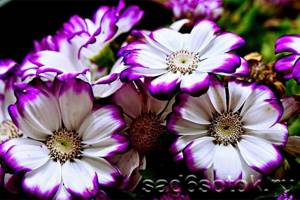
Rules for caring for bloody cineraria
The plant is propagated by seeds, cuttings, and dividing the bush.
All types of cineraria can be grown from seeds. By other methods, only decorative foliage plants are propagated.
Cuttings
In the summer, shoots 10 cm long are cut from the plant you like. Then they are placed in a glass or jar of water. The liquid level should be less than half the height of the cuttings so that the plants do not rot. After the young roots appear, the cuttings are planted in the ground.
Rooting can be done directly in the ground. To do this, the chopped shoots are slightly dried and planted in containers with a damp substrate. Drainage is first placed at the bottom. For rooting, you can use either purchased soil or a self-prepared mixture of sand and non-acidic peat. For disinfection, the surface is watered with a solution of potassium permanganate. The box with cuttings is carefully covered with a transparent plastic bag and placed in a warm place with dim light. To prevent the plants from getting too steamy, they are periodically ventilated. After 2–3 weeks, the shoots should take root.
Dividing the bush
The procedure is carried out before flowering begins. The overgrown bush is removed from the ground and carefully divided so that each part remains with roots and an above-ground shoot.


